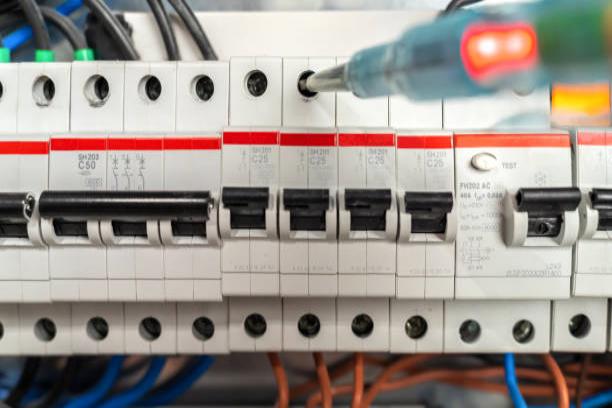The Significance of Residual Current Circuit Breaker in Electrical Safety
Residual Current Circuit Breaker (RCCB) is a crucial component in any electrical system, designed to ensure the safety of individuals and property. It plays a pivotal role in protecting against electric shocks and electrical fires, making it an essential device in both residential and commercial settings. This article aims to provide a comprehensive understanding of what a residual current circuit breaker is, how it works, and why it is vital for electrical safety.
Defining Residual Current Circuit Breaker (RCCB)
Residual Current Circuit Breaker, commonly referred to as RCCB, is an electromechanical device that automatically interrupts the flow of electrical current when it detects a leakage or imbalance. Its primary function is to protect against electric shock caused by faulty electrical appliances or wiring. By monitoring the current flowing through the circuit, the RCCB instantly cuts off the power supply when a fault occurs, preventing potential hazards.
The Working Principle of RCCB
RCCBs operate based on the principle of detecting a difference between the current flowing into and out of a circuit. This difference, also known as residual current or earth leakage current, indicates the presence of a fault. The RCCB continuously compares the incoming and outgoing currents, and if an imbalance exceeds a predetermined threshold, it trips the circuit, thereby interrupting the power supply. This swift response significantly reduces the risk of electrical accidents and injuries.
Types of Residual Current Circuit Breakers
There are two main types of RCCBs available: the two-pole RCCB and the four-pole RCCB. The two-pole RCCB is commonly used in single-phase electrical systems, where it protects against direct and indirect contact with electric current. On the other hand, the four-pole RCCB is used in three-phase electrical systems and provides additional protection against leakage currents and potential phase-to-phase faults. Both types are essential for maintaining electrical safety.
Importance of Residual Current Circuit Breaker in Electrical Safety
Residual Current Circuit Breakers are essential for ensuring electrical safety due to their ability to quickly detect and respond to faults. They provide protection against various electrical hazards, including electric shock, electrical fires, and damage to electrical equipment. By promptly cutting off the power supply, RCCBs prevent the risk of severe injuries and potential loss of life, making them a critical component in any electrical installation.
Installation and Testing of RCCBs
Proper installation and regular testing of RCCBs are crucial for their effective functioning. The RCCB should be installed by a qualified electrician, following the manufacturer's instructions and local electrical codes. Additionally, periodic testing is essential to ensure that the RCCB is operating correctly. This involves performing a test using the built-in test button to verify its responsiveness and accuracy. Regular maintenance and testing help maintain the integrity of the RCCB and ensure its reliability in times of need.
Residual Current Circuit Breakers and Ground Fault Circuit Interrupters
While both Residual Current Circuit Breakers (RCCBs) and Ground Fault Circuit Interrupters (GFCIs) serve a similar purpose of protecting against electric shocks, there are some differences between the two. RCCBs are primarily used for protection against earth leakage currents and are typically installed in the main distribution panel. GFCIs, on the other hand, are installed at specific outlets and provide localized protection. Understanding the differences and appropriate usage of these devices is crucial for maintaining electrical safety.
Common Applications of Residual Current Circuit Breakers
RCCBs find application in a wide range of electrical installations. They are commonly used in residential buildings, commercial complexes, hospitals, laboratories, and industrial facilities. Additionally, they are also extensively used in outdoor electrical systems, such as swimming pools and gardens, to provide protection against potential electrical hazards. The versatility of RCCBs makes them an indispensable component in ensuring electrical safety in various settings.
Choosing the Right Residual Current Circuit Breaker
When selecting an RCCB, several factors should be considered, including the nominal current rating, sensitivity, and tripping characteristics. The nominal current rating should be chosen based on the maximum load of the circuit, while the sensitivity determines the level of fault current required to trip the RCCB. Additionally, the tripping characteristics should be compatible with the specific application. Consulting with a qualified electrician or electrical engineer can help in choosing the right RCCB for a particular electrical system.
Maintaining Electrical Safety with Residual Current Circuit Breakers
Residual Current Circuit Breakers are key elements in maintaining electrical safety. However, it is important to remember that they are not a substitute for proper electrical system design, installation, and maintenance. Regular inspection of electrical systems, adherence to safety standards, and immediate resolution of any identified faults or issues are crucial for overall electrical safety. By combining the use of RCCBs with other safety measures, the risk of electrical accidents can be significantly reduced.

